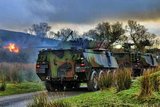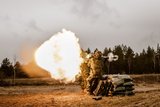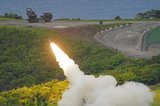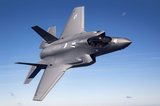North Korea blows up frontline bunkers
Pyongyang blew up ten guard posts in the Demilitarized Zone on 20 November as the two Koreas pursue a reconciliation drive, even while denuclearisation talks stall between the US and the North.
The move is one of the steps agreed during the Pyongyang summit between the South's President Moon Jae-in and the North's leader Kim Jong Un in Pyongyang in September.
The North told the South that it would blow up the ten facilities almost simultaneously, Seoul's defence ministry said, adding that Southern soldiers ‘observed and confirmed the guard posts were completely ruined at the announced time’.
Seoul has been tearing down ten guard posts of its own, mostly using excavators, a defence ministry spokesman said.
The North has more of the facilities - which include both surface structures and underground elements - and according to Yonhap news agency the move will leave it with around 150 in the area, with the South having about 50.
President Moon has pursued a policy of engagement with its isolated, nuclear-armed neighbour, in increasing contrast to Washington, which insists pressure should be maintained on Pyongyang until it denuclearises.
Despite its name the area around the DMZ is one of the most fortified places on earth, replete with minefields and barbed-wire fences.
But under plans to ease tensions agreed in Pyongyang, the two Koreas are demilitarising the border truce village of Panmunjom, to leave it manned by 35 unarmed personnel from each side.
Officially called the Joint Security Area (JSA), the enclave is the only spot along the 250km frontier where soldiers from the two Koreas and the US-led UN Command stand face-to-face.
More from Defence Notes
-
![Taiwan approved for purchase of $11 billion in weapons from US]()
Taiwan approved for purchase of $11 billion in weapons from US
The US State Department’s approval of a multi-billion-dollar sale of weapons to Taiwan includes tactical mission networks equipment, uncrewed aerial systems, artillery rocket systems and self-propelled howitzers as well as anti-tank guided missiles.
-
![US National Security Strategy prioritises advanced military capabilities and national industry]()
US National Security Strategy prioritises advanced military capabilities and national industry
The 2025 NSS has emphasised investment in the US nuclear and air defence inventory and national industry, but it leaves multiple unanswered questions on how the White House will implement this approach.
-
![Canada set to look away from its neighbour and across the Atlantic for partners]()
Canada set to look away from its neighbour and across the Atlantic for partners
While non-EU UK struggles to join the Security Action for Europe initiative, which provides loans for defence programmes, Canada has become the first country outside Europe to get access – and did so for a nominal fee.
-
![NATO experiments with solutions to integrate networks, AI and uncrewed systems]()
NATO experiments with solutions to integrate networks, AI and uncrewed systems
During the latest edition of the NATO DiBaX, the alliance tested multiple capabilities to inform requirements for future efforts.
























